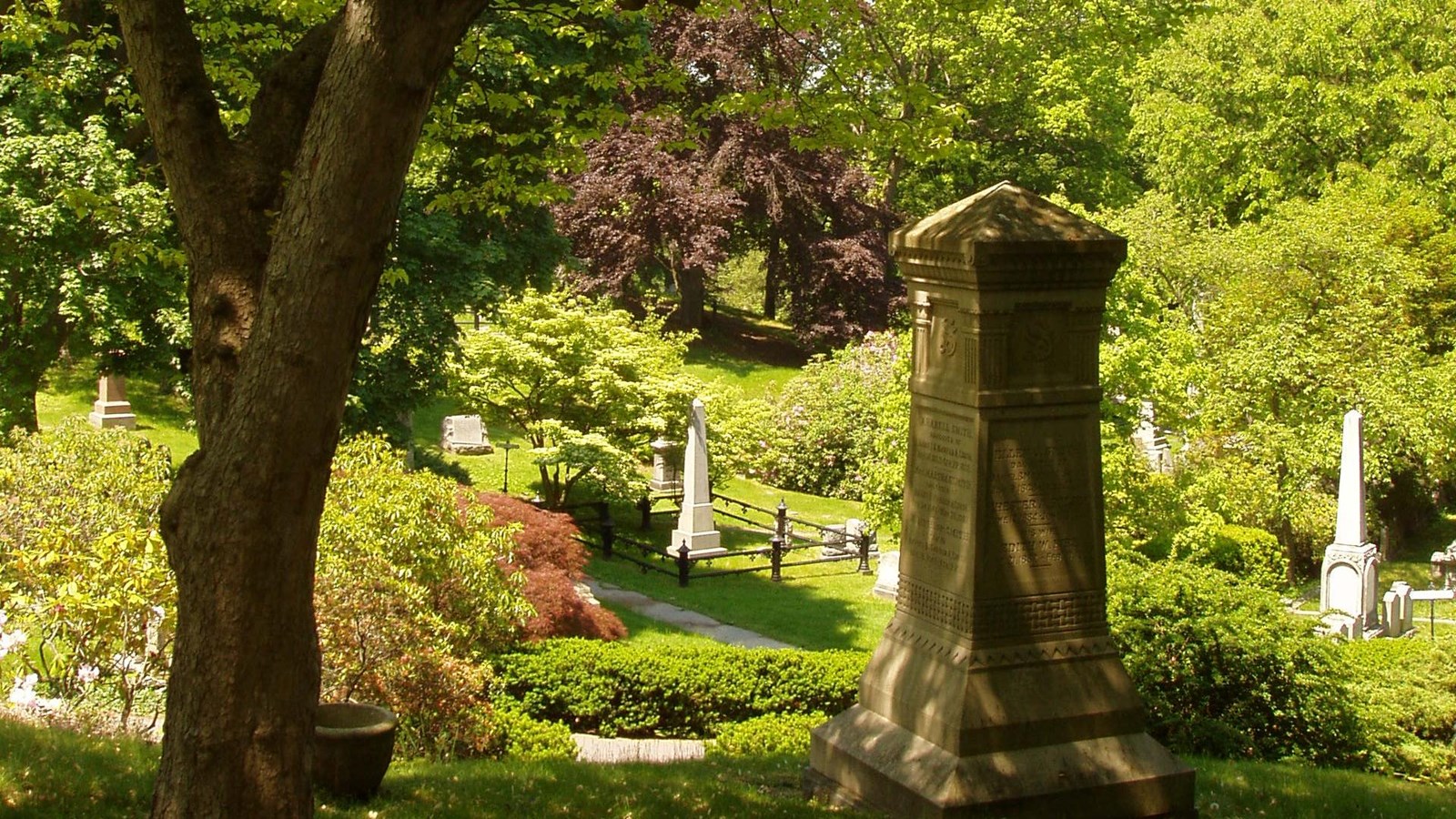Last updated: August 28, 2020
Place
Mount Auburn Cemetery

Photo by Daderot, CC BY-SA 3.0
Mount Auburn Cemetery is the first landscaped rural or “garden” cemetery in the United States. Established in 1831 in Watertown and Cambridge, Massachusetts, the cemetery was not only designed as a resting place for the deceased, but also as an attraction and pleasure ground, with picturesque landscapes, winding paths, a variety of horticulture, and sculptural art. Its success inspired other cemeteries’ designs and in turn articulated the need for public parks and gardens launching the American parks movement.
In the early 19th century, Dr. Jacob Bigelow’s concern that crowded cemeteries in congested urban areas might promote the spread of contagious diseases spawned his idea for Mount Auburn Cemetery. In 1825, Bigelow, a Boston physician and Harvard professor, invited a group of civic leaders to his house and proposed that they establish a new kind of cemetery. Located on the outskirts of the city, the new cemetery would place family burial lots in a landscaped setting filled with trees, shrubs, and flowers. In 1831, Bigelow’s idea became a reality when the newly formed Massachusetts Horticultural Society agreed to take a lead role in developing a rural cemetery. They located a 72-acre farm in Watertown and Cambridge that was an ideal location for the cemetery and for an associated experimental horticultural garden. The key feature was a 125-foot central hill that provided spectacular views of Boston and Cambridge.
Henry A.S. Dearborn, President of the Massachusetts Horticultural Association, was largely responsible for the cemetery’s design. Influenced by European naturalistic landscape design ideas, Dearborn incorporated ideas from English landscaped parks and the Père Lachaise Cemetery in Paris into his design for Mount Auburn Cemetery. Working with civil engineer Alexander Wardworth, Dearborn laid out the cemetery with winding roads that followed the natural contours of the land, naturalistic landscaping elements including wooded areas and reflective ponds, and panoramic views from the central hill’s summit.
Dearborn also established a separate experimental garden at Mount Auburn, planted with many domestic and exotic varieties of fruits, flowers, and vegetables. As news of the garden cemetery spread, horticulturalists from around the world sent gifts of seeds, including magnolia trees from Ohio and vegetable seeds from the London Horticultural Society. These gift plantings became part of both the horticultural garden and cemetery. By the end of the 1830s, Mount Auburn had several hundred trees planted.
The popularity of the new cemetery grew, and new cemetery lots sold quickly. In 1835, the cemetery became a private nonprofit corporation severing its relationship with Dearborn, and the experiential garden ended. The cemetery has continued to embrace horticultural experimentation and high standards of horticultural maintenance and practices as part of its mission.
Mount Auburn Cemetery has played an important role in conservation thinking by creating a designed landscape open to the public. The popularity of the design led to political support for local and regional parks and park systems. Mount Auburn has continued to incorporate conservation ideas over time. By 1870, with the growing interest in Mount Auburn as a destination for birdwatching, the Mount Auburn Trustees established a Committee on Birds that recommended plantings of trees and fruit-bearing shrubs that would attract birds. In the 20th century, Mount Auburn President Oakes Ingalls Ames further developed the cemetery’s landscape as an arboretum and a bird sanctuary with his “hands-on” approach to managing the cemetery.
Mount Auburn Cemetery currently has a collection of over 5,500 trees, shrubs and other plants from around the world that cover the 175-acre cemetery. More than half of the trees on the grounds display labels, which give the botanic and common names, the date planted, and the native range of the species. Mount Auburn is also designated as a Massachusetts Important Bird Area. Some current conservation initiatives include planting native New England plants in the Consecration Dell area, managing the four ponds to provide good habitat for wildlife, and practicing Integrated Pest Management (IPM) for control of insects.
Many famous Bostonians lie buried in Mount Auburn Cemetery. Some have important conservation connections, including Jacob Bigelow (founder of Mount Auburn Cemetery), landscape architect Charles Eliot, activist Harriet Lawrence Hemenway (founder of Massachusetts Audubon Society), Horace Gray (who established a horticultural garden in the Boston Public Garden in 1838), Asa Gray (American botanist), and ornithologists William Brewster and Ludlow Griscom. Other distinguished people include Henry Cabot Lodge and Henry Cabot Lodge, Jr. (U.S. senators), Dorothea Dix (activist), Henry Wadsworth Longfellow (educator and poet), Oliver Wendell Holmes (author and poet), Julia Ward Howe (author and reformer), and Charles Sumner (abolitionist and U.S. senator). The Secretary of the Interior designated the cemetery a National Historic Landmark in 2003.
Mount Auburn Cemetery is located at 580 Mount Auburn St. in Watertown and Cambridge, MA. It has been designated a National Historic Landmark. For more information, visit the Mount Auburn Cemetery website.
To discover more Massachusetts history and culture, visit the Massachusetts Conservation Travel Itinerary website.
